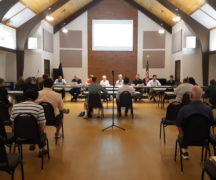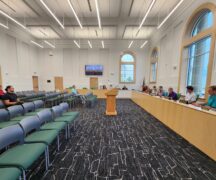By JAN LARSON McLAUGHLIN
BG Independent News
In recent years, the housing market in Bowling Green has shrunk to dismal numbers. When BG Economic Development Director Kati Thompson asks local Realtors about local residential listings, the numbers are often in the single digits.
On Wednesday evening, the Bowling Green Planning Commission took action that could boost those numbers.
The commission voted 7-0 to recommend the rezoning of 37 acres to R-2 to allow for 130 new single-family homes, with starting prices of $225,000. The recommendation will now go to City Council for final action on the request.
The acreage, at the southwest corner of Brim and Newton roads, is currently zoned M-3 business park. The land is owned by the BG Economic Development Foundation.
“We’ve tried to market that property for more than 20 years,” for industrial use, Thompson said.
So after a great deal of talk about the housing shortage in Bowling Green, the foundation shifted gears on the property. The addition of more housing in the community could aid the city in attracting and retaining business, Thompson said.
Planning commission member Mark Remeis, who is a Realtor, echoed Thompson’s assessment of the local housing market.
“There’s a massive gap in our market for moderately-priced homes,” he said.
In fact, Bowling Green’s housing numbers have been the lowest of all communities in the Toledo regional market, according to Remeis. The lack of housing options has been blamed for people buying homes in Perrysburg and Findlay and commuting to Bowling Green for work.
“We have less inventory than any other communities,” Remeis said.
And the need is critical with Abbott Laboratories building on the northern edge of Bowling Green – bringing 450 jobs and people in need of homes.
“We all know Abbott is coming in a couple years. We’d like to have some housing available for them,” said Planning Commission President Bob McOmber, who stressed that the homes should be affordable to the average plant worker – not just to management.
“I think everybody agrees on the need for housing in Bowling Green,” he said.
At the same time, McOmber realized that times have changed – with a home valued at $150,000 five years ago now selling for $225,000. That’s a far cry from when McOmber bought his first home for $30,000, which was a sum that made his hands shake as he signed the deal.
Remeis agreed that homes in the $225,000 to $275,000 range are greatly needed in Bowling Green.
“There’s a massive gap in our market of moderately priced homes,” he said. “I don’t think we need any more $400,000 to $450,000 homes.”
In response to the need for housing, the economic development office put out feelers for a developer of the site, and selected Triban Investment of Cleveland.
In a letter to the planning commission, Triban officials said they have been working with Bowling Green Economic Development for more than a year to make the project a reality.
“We intend to make a significant investment in this site in support of the strategic goals of the city of Bowling Green related both to the development of this specific property as well as the overall goal of increased levels of for-sale housing construction and home ownership,” the letter stated.
“Triban has a long history of working in a collaborative fashion with all stakeholders to find creative and economically viable solutions that result in successful development projects,” the letter said. “We are confident that rezoning this site for residential use will allow us to move forward with another successful project.”
“We think there is a strong market for residential new construction and a need for new housing stock, which will be a complement to the job growth in this area,” the letter said.
Triban will be working with K.Hovnanian to construct all the homes in the new subdivision. Construction is expected to begin this summer, Thompson said.
The development is near the BG Community Center, the Wood County Fairgrounds, and the BG Middle School and High School.
Just to the south of the new housing on Brim Road is the former Wall Street Journal facility, now operated by two companies, Vital and FHR North America LLC. When the businesses learned of the plans for a housing development, they reached out to Thompson’s office to talk about their expansion plans and the noise that may come with those plans.
So the industries and the subdivision developers have been discussing how they can be good neighbors, making accommodations such as adding mounding and trees between the properties, Thompson said.
“Everyone wants to be a good neighbor. I think we’ve found a path for both parties,” she said.
A few members of the public expressed some concerns about the rezoning request. Julie Smith Maekesk, who lives in the nearby Village Subdivision, questioned the affordability of the homes and the plans to fit 130 houses on the acreage.
Initially, the developer ballparked the numbers of homes that could fit on the acreage at 150. But upon closer study, the number of homes was revised to 130. Thompson said the lot sizes meet the R-2 zoning requirements.
While he agreed that Bowling Green needs housing, Don Scherer said he is not in favor of single-family housing there. Townhouses or row houses would provide more affordable types of residences, he said.
Planning commission member Nate Spitler said he shared those concerns about affordability.
“We do need more affordable homes of all varieties,” he said.





